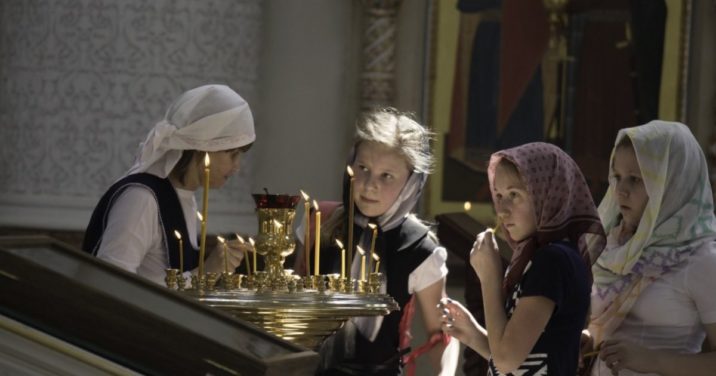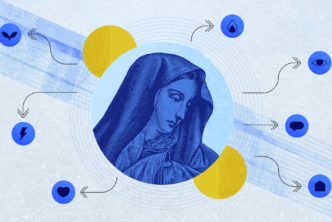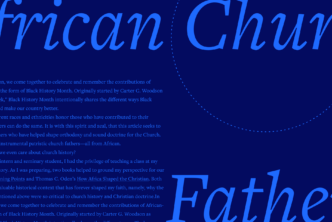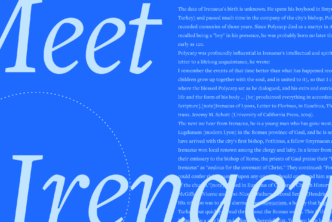The Gates of Hell, available now from Lexham Press, offers a unique glimpse into the lives of ordinary Christians (with extraordinary faith) living in the world’s first atheist nation, the Soviet Union. Author Matthew Heise tells the stories of German-Russian Lutherans who remained faithful to the end when facing state persecution, attesting to the enduring power of God’s Word and his faithfulness that “the gates of hell shall not prevail.”
And it’s timely.
Ukrainian Lutheran Church Bishop V’yacheslav Horpynchuk says the book will help Christians today to “recognize the signs of the time so that we are not lulled by songs of the world and the devil and caught in their traps unprepared.”
In this excerpt adapted from chapter 2 of The Gates of Hell, Heise explores how the Lutheran Church appeared in a land that had been so closely tied to the Russian Orthodox Church since Vladimir the Great adopted Christianity in AD 988.
***
In the sixteenth century, desiring to modernize his country, Ivan the Terrible (1547–1584) carried on the tradition of his father by inviting educated and skilled European tradesmen into Russia. Lutherans were among these tradesmen, and as they began to settle in Russian cities and villages, they asked to build their own churches. Being theologically curious, the czar asked for a statement of what they believed. The Lutherans presented him with the Augsburg Confession, which the czar rejected violently.1 Nonetheless, since European Lutherans were essential to the workforce, Ivan allowed them to live in the Nemetskoe Sloboda (German Settlement), an area just outside the Moscow city limits. In 1576 the czar permitted the first Lutheran church, St. Michael’s, to be built in Moscow.
However, four years later he reneged on his permission, calling for St. Michael’s to be burned down.2 Thus began the precarious existence of the Lutheran Church in Russia. In future years, succeeding czars would be at times repressive or favorable to the Lutheran Church. Peter the Great and Catherine the Great, for example, were more than agreeable to the presence of the Lutherans, advocating for the benefits that they could bring to Russia. Catherine would submit a manifesto on July 22, 1763, inviting Germans into Russia to settle the land of the Volga River valley. As a result, 59 Lutheran churches, 33 Roman Catholic, and 23 Reformed churches were built by the settlers of the Volga.
Russia’s early Lutheran Christians
Although Germans would constitute the bulk of Lutheran believers in Russia, the remainder of Lutherans would come from various ethnicities: Finns, Swedes, Estonians, Latvians, even Armenians. (Ethnic Russians would not be allowed to leave the state Orthodox Church and become Lutheran until political reforms secured freedom of conscience in the early twentieth century.)
Extending their influence throughout the Russian Empire, Czar Alexander I (1801–1825) invited German Lutherans to settle in what constitutes modern-day Ukraine and Georgia. His brother and successor, Nicholas I (1825–1855), brought the Lutheran Church under the state’s more formal control when he signed a document making him titular head of the Church, much like the King of Great Britain at the time, William IV, was considered the head of the state Anglican Church.3
Russian czars, many of whom had partial German ancestry, respected the role that Lutherans played in civil society, from their schools with strong academic credentials to the service they provided in governing Russia. Famed Russian conductor Modest Mussorgsky was among the many notable citizens who graduated from St. Petersburg’s legendary Lutheran school, the Peterschule.4
A further example of Lutherans’ positive influence can be found in Sts. Peter and Paul Pastor Heinrich Dieckhoff, who was renowned for founding schools for the deaf and blind in Moscow in the latter half of the nineteenth century.5
The Lutheran Church was also admired for other charitable institutions, such as homes for widows and orphans, and aid they procured for the poor and destitute. The outbreak of World War I, though, caused some Russians to doubt the loyalty of Russian Germans, leading to violence. Eighty-four Lutheran pastors were imprisoned, some exiled to Siberia. Nevertheless, in 1917 there were still 3,674,000 Lutherans and approximately 1,828 churches and prayer houses scattered throughout Russia.6
Shortly after the anniversary celebrations of the Reformation in Russia were concluded, seething anger over a seemingly pointless war and a lack of bread led Russians to rebel against their ruler, Czar Nicholas II. The three-hundred-year rule of the Romanov family was abruptly brought to an end in February 1917 as the provisional government under Alexander Kerensky took power. In the beginning, Lutherans were encouraged, perceiving the revolution as a “liberating event” for the Church.7 Despite having lived in Russia for centuries and demonstrating their loyalty to the state, German Lutherans were often considered a “fifth column” by the Czar’s administration during World War I.
The official use of the German language was forbidden at that time, although as regards church services it only seems to have affected congregations in the Ukrainian region. Still, Bibles and books could no longer be imported, and charitable institutions were forcibly requisitioned by the czarist authorities. When the buildings were returned, they were in such a deplorable condition that it would cost great sums to repair them. Pastors, especially those of Baltic German heritage, were deported because they had received mission funds from abroad. Rev. Richard Walter of Sts. Peter and Paul in Moscow had his home searched seven times all because he had shown concern for prisoners of war in Moscow.
The most horrible example of the czarist regime’s anti-Germanism occurred when a pogrom was carried out against the German population of Moscow in May 1915. With the Moscow police force taking a laid-back approach, a three-day riot against Russian-Germans resulted in the plundering and burning of businesses and churches and even led to several murders.8 Given the deteriorating relationship between Russian-Germans and the czarist government, it could hardly be a surprise that they had high hopes after the February Revolution. They were not to be disappointed, either, as the Provisional Government immediately released prisoners and allowed banned Lutheran pastors to return.9
In the summer of 1917, Bishop Conrad Freifeldt of Saint Petersburg was allowed to hold a church conference with the hope of forming a new ecclesiastical structure. The Lutherans under Freifeldt desired to democratize their church, allowing more rights for the congregations. Latvians, Finns, Swedes, and Estonians also participated in the conference, with the stated goal of holding a General Synod in January 1918.10
Lutherans in Russia were cautiously optimistic that the new government would allow them to return to normal church life.11 But in October of 1917, those hopes were dashed.
The Bolsheviks’ impact on religion in Russia
The Provisional Government was usurped by a new group of anti-government rebels, Communists known as the Bolsheviks. As philosophical materialists, the Bolsheviks were intent on eradicating all traces of religion from Russian society. While they would initially move in pragmatic manner, retreating when they encountered resistance, there was little doubt that they wanted the extermination of religion within the Russian Empire.12
As the state church of the czars, the Russian Orthodox Church suffered the full brunt of their blows. But since Lutherans had endured persecution under the czars, in the beginning they hoped that the Bolsheviks’ more democratic tendencies might allow them to survive, albeit under the rule of a government averse to religion.13 However, the first actions of the new government were not only directed against the Orthodox but were a concerted attack on all Christian denominations.

But matters were about to get worse. These initial actions of the government were but a precursor to the landmark January 20, 1918, Decree on Separation of Church from State and School from Church. This decree would prove to be the primary operating statement of the Bolshevik government toward religion throughout the 1920s. First, by separating church from state, old traditions like the use of religious oaths and Christian symbols in state institutions and buildings were forbidden. Second, by separating school from church, Christian schools were now outlawed. Historic Lutheran schools like St. Anne’s in St. Petersburg were nationalized, the former teachers, for the most part, fired, and a new generation of teachers employed who no longer taught religion. St. Anne’s was now labeled School Number 11.15
Other Lutheran schools also could not teach religion. Sts. Peter and Paul in Moscow, for example, lost control of its school board and saw academic standards fall precipitously.16 St. Peter’s Lutheran school in St. Petersburg was unique in that its administration and staff was given a period of grace, and it survived until principal Erich Kleinenberg and the Lutheran teachers were fired in the late 1920s.17
The church is separated from the state
Through this January decree and the nationalization of land and property, the notion of church property had become anachronistic. Congregations, now known as “religious groups,” lost their legal status and had all their property confiscated. St. Peter’s Lutheran in St. Petersburg had its property valued in several millions, so this was a considerable loss.18 If a congregation wanted to use its own building, often property that had been built and maintained for centuries, permission had to be requested from the government.19
Although the Bolsheviks in most instances allowed the use of the buildings, their message to Christians was clear: The government now owned the buildings and could use them for any secular or anti-religious purpose they chose.20To receive permission to use the church building, religious groups had to form a dvatsatka (the Russian number for 20) of 20 parishioners operating along the lines of a church council. The dvatsatka would then sign an agreement with the local authorities, who would allow them to use the building, as long as they maintained and insured it.21
The outcome of the Bolsheviks’ actions was to take religion from being a public matter and relegate it to the private sphere. An inclination toward pragmatism may have led Vladimir Lenin and other moderates to first write in the January Decree that “religion is the private affair of every citizen of the Russian Republic.” He soon replaced this phrase with “the church is separated from the state.”22 Later, in July 1918, Lenin would advocate using the phrase “freedom of religious and anti-religious propaganda” in the new constitution. This sounded as if religious believers were being given equal rights with atheists in Russian society.
But due to the weakening of the church through the January 20 Decree, the Bolsheviks knew well that there was no real equality of expression.
They held all the cards.23
***
Continue reading about how the Lutheran Church persevered in Russia in The Gates of Hell, available now from Lexham Press.
Related articles
- What Is the Orthodox Faith? 9 Facts about the Orthodox Church
- How Church History Guards against Being a Theological Bully
- 5 Solas of the Reformation—What They Are & Why They Matter
Learn more about the history of the Lutheran Church in these resources
Church History, Volume Two: From Pre-Reformation To The Present Day
Regular price: $47.99
- Olga A. Litzenberger, Evangelical Lutheran Church in Russian History: 16th-20th C. (Moscow: Lutheran Heritage Foundation, 2003), 33–35.
- Litzenberger, Evangelical Lutheran Church in Russian History: 16th–20th C., 39–40.
- Timothy J. Wengert, ed., Dictionary of Luther and the Lutheran Traditions (Grand Rapids: Baker Academic, 2017), 650–51, 733.
- Maxim Ivanov, Lutheran Quarter of Petersburg (Saint Petersburg: Russia, European House, 2004), 59, 61.
- Wengert, Dictionary of Luther and the Lutheran Traditions, 193–94.
- Wengert, Dictionary, 651.
- Johannes Schleuning, Heinrich Roemmich, and Eugen Bachmann, Und siehe, wir leben!: Der Weg der evangelisch-luthersichen Kirche Russlands in vier Jahrhunderten (Erlangen, Germany: Martin Luther-Verlag, 1977), 105.
- Victor Dönninghaus, Die Deutschen in der Moskauer Gesellschaft: Symbiose und Konflikte (1494–1941) (Munich: R. Oldenbourg Verlag, 2002), 373–74.
- Richard Walter Report, July 18, 1919, NLC Papers, Archives of ELCA.
- Litzenberger, Olga. Евангелическо-Лютеранская Церковь в Россиской Истории (XVI–XX vv.) [The Evangelical Lutheran Church in Russian History (16th–20th c.)] (Moscow: The Lutheran Heritage Foundation of Education and Culture, 2003), 227–32. The synod would not be allowed for yet another six years (1924).
- Schleuning et al., Und siehe, wir leben, 106.
- William B. Husband, Godless Communists: Atheism and Society in Soviet Russia, 1917–1932 (Dekalb, IL.: Northern Illinois University Press, 2000), 48. “Soviet society would be nonreligious rather than anti-religious in the immediate future.”
- Richard Walter Report, July 18, 1919, NLC Papers, Archives of ELCA.
- Richard Pipes, Russia under the Bolshevik Regime (New York: Vintage Books, 1995.), Kindle edition, loc. 8454 of 14900.
- Archimandrite Augustine, “Annenschule,” in Karev, V. Editor, Немции в России: Энциклопедия Тоm 1, A–И [Germans of Russia: Encyclopedia. Volume 1, A–И] (Moscow: ERN, 1999), 43.
- Richard Walter Report, Archives of ELCA. Sts. Peter and Paul in Moscow had built a boys’ school during the war for 650,000 rubles, the equivalent of $325,000. That school now became state property.
- P. Ulyanov, “Судбы Учителей Петришуле, 20–30 г.” [“Fate of the Teachers at the Peterschule, 1920–30s”], in Немции в России: Люди и Сулбы [Germans in Russia: People and Fates] (St. Petersburg, Russia: 1998), 203.
- March 21 Report, NLC, 1919, NLC Papers, Archives of ELCA
- Husband, Godless Communists, 45–46.
- Robert Conquest, Religion in the USSR (London: Bodley Head, 1968), 14.
- Edward E. Roslof, Red Priests: Renovationism, Russian Orthodoxy, and Revolution, 1905–1946 (Bloomington, IN: Indiana University, 2002), 23.
- Husband, Godless Communists, 47, 184.
- N. S. Timasheff, Religion in Soviet Russia: 1917–1942 (New York: Sheed and Ward, 1942), 22.






